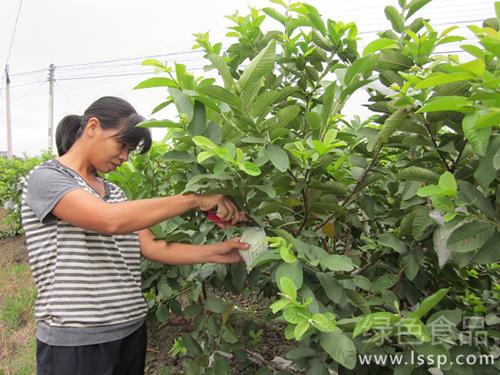Perennial flowering and fruiting, good benefit and autumn management of pearl guava
In autumn and winter, drought and little rain, cold and heat are impermanent, frost is often present, which is not conducive to the growth of guava. Appropriate methods should be adopted to create a favorable environment for guava to grow normally. After years of practice, fruit growers have come to the following experience:

Guava harvest
1. Proper inhibition of growth and promotion of flowers by drugs: guava grows fast in summer high temperature and humidity, and most of the branches and leaves are luxuriant and shoots are strong. After entering August, the flowering node of guava increased. According to the fruit node theory of guava, there were more in 2, 4 and 8 nodes, but there were a few flowers in 8-12 nodes. In addition, there are many branches, all of which grow only, and the fruit setting rate is not high. After spraying with B9 (Bijiu) 1000-2000ppm in late August, the number of flowers increased sharply. At the same time, it can be combined with heart picking, section 5 or 9 to promote the formation of flowers in section 4 or 8. After taking measures, the number of flowers is often 2 times more than that of untreated flowers, and these flowers are easy to set fruit. However, when using drugs to promote flowers, the drugs are also different in different seasons. After entering November, the weather turns cold, using dwarf to promote flowers and protect flowers, can effectively prevent florets from cold injury. When using dwarf, borax should be used in conjunction with it. Daizhuangsu is easy to increase the bitterness of guava, but borax can reduce bitterness and increase sweetness.
2. Pest control: anthracnose is the main pest of guava in autumn and winter. 70% methyl thiophanate wettable powder or 75% chlorothalonil 800 times solution can be used for prevention and control. The main insect pests are aphids, shell insects and poisonous moths. 24% DuPont Wanling water agent 1000 times can be used for control. If the pink scale is harmful to the tender shoots, the tender shoots will blacken and atrophy, and it is difficult to grow flowers. In addition, the generations of pests overlap, and drugs should be used continuously. Lufu, Kuiling, etc., kill insects obviously. When it is dry in autumn and winter, root nematodes are easy to occur, and seriously, guava orchards are barren. Mainly make the old leaves purple, gradually turn red, and finally die, from the bottom up, bare branches. If it is not controlled in time, the surrounding plants will have similar symptoms. Therefore, in autumn and winter, as soon as sporadic diseased plants are found, drugs must be used in time. When spreading with Diachongling, which is mixed with fine sand, the topsoil of the tree plate should be planed and the soil can be mixed to control the spread.
3. Rational use of foliar fertilizer: in autumn and winter, targeted use of foliar fertilizer has a better effect. The yield of guava can be increased by mixing 3% urea with 1% superphosphate. Mixing 0.2% borax with 0.5% potassium dihydrogen phosphate can promote fruit and increase sweetness. Due to the lack of light in autumn and winter, the decrease of photosynthesis, and the fruit hanging for many times, the flavor of guava becomes weak, so farm fertilizer and foliar fertilizer should be used at the same time.
Related
- Fuxing push coffee new agricultural production and marketing class: lack of small-scale processing plants
- Jujube rice field leisure farm deep ploughing Yilan for five years to create a space for organic food and play
- Nongyu Farm-A trial of organic papaya for brave women with advanced technology
- Four points for attention in the prevention and control of diseases and insect pests of edible fungi
- How to add nutrient solution to Edible Fungi
- Is there any good way to control edible fungus mites?
- Open Inoculation Technology of Edible Fungi
- Is there any clever way to use fertilizer for edible fungus in winter?
- What agents are used to kill the pathogens of edible fungi in the mushroom shed?
- Rapid drying of Edible Fungi



